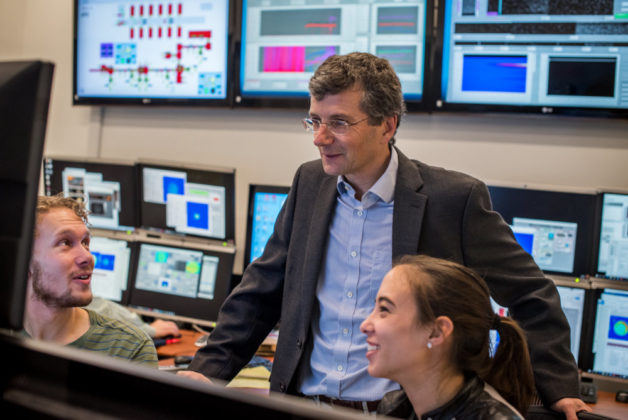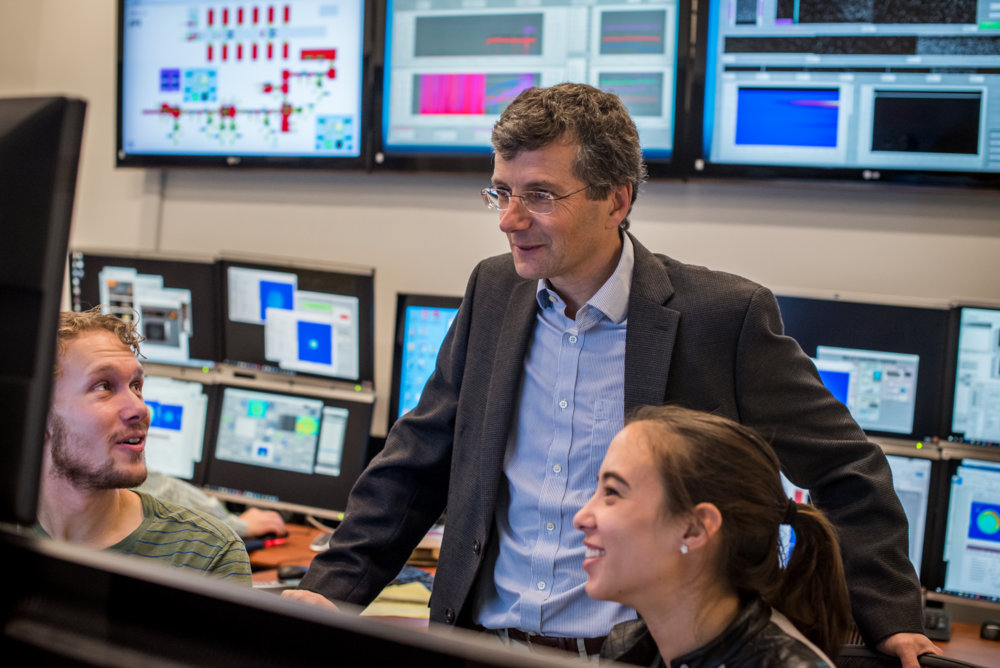
Wim Leemans, director of Berkeley Lab’s Accelerator Technology & Applied Physics Division, speaks with graduate students Joost Daniels, left, and Kelly Swanson in the BELLA laser control room. Berkeley Lab’s BELLA Center is the site of a laser plasma wakefield acceleration R&D effort and other laser experiments that could help set the stage for a next-generation particle collider. (Credit: Paul Mueller)
A set of new laser systems and proposed upgrades at the Department of Energy’s (DOE) Lawrence Berkeley National Laboratory (Berkeley Lab) will propel long-term plans for a more compact and affordable ultrahigh-energy particle collider.
Progress on these laser systems and laser-driven accelerators could also provide many spinoffs, such as a new tool to hunt for radioactive materials, and a miniaturized and highly tunable free-electron laser system enabling a range of science experiments.
These efforts are outlined in a DOE-sponsored workshop report that focuses on a set of 10-year road maps designed to kick-start R&D driving a next-generation particle collider for high-energy physics. The ultimate goal is a machine capable of exploring physics beyond the reach of CERN’s Large Hadron Collider (LHC). Today’s most powerful collider, the LHC enabled the discovery of the Higgs boson that resulted in the 2013 Nobel Prize in physics.
The LHC, with a main ring 17 miles in circumference, collides protons—subatomic particles liberated from the center of atoms—at collision energies of up to 13 trillion electronvolts (13 TeV).
Meanwhile, proposals for next-generation linear colliders would collide electrons and their antiparticles, positrons, at lower energies—from a few hundred billion electronvolts (GeV) up to a few TeV. And while the collision energies of these machines would be lower than those of the LHC, the physics of their electron-positron collisions would be complementary, enabling more specific, detailed measurements for some particle properties and phenomena.
Building a TeV-level electron-positron collider with today’s accelerator technology is possible but would be expensive due to its great size (its footprint would likely measure more than 20 miles).
In an effort to reduce the scope and associated cost of a next-generation collider, the Office of High Energy Physics within DOE’s Office of Science brought together more than two dozen experts from DOE and across the country to prepare an Advanced Accelerator Development Strategy Report that sets goals for three potentially game-changing accelerator technologies over the next 10 years.
Among other recommendations, the report highlights the need for R&D at BELLA, the Berkeley Lab Laser Accelerator, which is based on one of those three technologies: a laser-driven plasma wakefield accelerator (LWFA). This form of acceleration uses a laser or lasers to accelerate electrons to high energies.
Two other wakefield acceleration concepts being developed elsewhere—one for a particle-beam-driven accelerator, the other for a dielectric wakefield accelerator—are also included in the road map.
Other acceleration techniques are in development that are outside the scope of the report, including an R&D effort based at CERN called AWAKE that is exploring proton-driven plasma wakefield acceleration.
The new approaches to particle acceleration endorsed in the report all offer potential ways to shrink high-energy particle accelerators by creating compact, dense waves of plasmas—formed in hot, highly charged gases—that rapidly accelerate bunches of precisely placed electrons like a surfer riding on an ocean wave.
BELLA researchers have already demonstrated a modular LWFA setup for reaching high energies, and are now working to improve upon this. The near-term goal outlined in the report is to achieve electron-beam energies of 10 GeV, up from BELLA’s current world record of 4.3 GeV.
“Once we have 10 GeV beams it will open up a whole new host of things. It will be a major step forward,” said Wim Leemans, director of the Lab’s Accelerator Technology & Applied Physics Division. The 10 GeV goal is significant because it represents an energy threshold for generating high charge positron beams, which would be required for a next-generation collider.
The LWFA road map, Leemans said, “gives us an anchor in the whole accelerator program” outlined for the DOE national laboratory complex.
The BELLA team will pursue two different approaches for achieving this 10 GeV goal: a single-accelerator-stage setup using a single laser, and a two-stage approach with two separate lasers.
The first stage will raise the electron beam energy to 5 GeV, and the second stage will accelerate the beam an additional 5 GeV, to 10 GeV. The second BELLA beamline for the two-beam setup could be constructed by the end of 2018, as outlined in the road map report, provided funding is available.
The report notes that in addition to advances in accelerator technology, there must also be new developments in laser technology, and supporting equipment such as mirrors, to realize this new type of collider.
BELLA now uses sapphire crystals doped with titanium to produce its laser light. To achieve far higher energies, and average beam power, the DOE report recommends pursuing other types of lasers, such as optical fiber, solid state, or carbon dioxide lasers, among other approaches.
A key technology challenge for BELLA is to make its pulses more rapid-fire, increasing from a current rate of about 1 pulse per second to a rate of about 1,000 per second, or 1 kilohertz (in a future development dubbed “K-BELLA”).
Ultimately, a pulse rate of 10,000 or 100,000 per second would be ideal for a next-generation collider, said Carl Schroeder, a Berkeley Lab senior scientist who leads theoretical and modeling efforts for BELLA experiments and has been working on conceptual designs and modeling for this LWFA collider.
If its R&D effort is successful, BELLA’s maximum energy should be sufficient to reach the 10 GeV acceleration milestone, said Anthony Gonsalves, a Berkeley Lab staff scientist who works on BELLA. “We’ve got plenty of room in the ‘tank’—there is a lot of headroom in energy that we haven’t even explored yet.”
Besides work to develop one-beam and two-beam approaches to a 10 GeV LWFA, the Lab’s development of a new, compact type of free-electron laser (FEL) and a separate portable gamma-ray source—to begin testing next year—may be the first important applications of the LWFA technology if the efforts prove successful.
FELs are highly tunable sources of light that can help explore matter down to the atomic and molecular scales with ultrabright pulses measured in femtoseconds, or quadrillionths of a second. The FEL project seeks to miniaturize X-ray FELs by replacing a kilometer-long conventional accelerating structure with a wakefield accelerator less than 10 meters long.
The plasma-based gamma-ray source, meanwhile, could prove to be a useful and portable tool for detecting nuclear materials.
Schroeder said, “The FEL and gamma-ray source are recognized as early applications of this technology. The laser systems for these experiments will be commissioned this winter.
“The roadmap lays out a rich program for the next decade,” added Leemans. “Key concepts are being developed towards future plasma based colliders, and BELLA, with upgrades, will enable the testing and development of many of these concepts.”
The BELLA Center is supported principally by the DOE Office of Science.
# # #
Lawrence Berkeley National Laboratory addresses the world’s most urgent scientific challenges by advancing sustainable energy, protecting human health, creating new materials, and revealing the origin and fate of the universe. Founded in 1931, Berkeley Lab’s scientific expertise has been recognized with 13 Nobel Prizes. The University of California manages Berkeley Lab for the U.S. Department of Energy’s Office of Science. For more, visit www.lbl.gov.
DOE’s Office of Science is the single largest supporter of basic research in the physical sciences in the United States, and is working to address some of the most pressing challenges of our time. For more information, please visit science.energy.gov.
